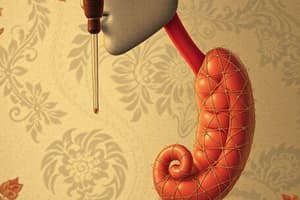Podcast
Questions and Answers
What are the potential minor complications associated with the insertion of a nasogastric tube?
What are the potential minor complications associated with the insertion of a nasogastric tube?
- Tracheobronchial aspiration
- Pneumothorax
- Intracranial Intubation
- Epistaxis (correct)
Which of the following steps is NOT part of the proper insertion process for a nasogastric tube?
Which of the following steps is NOT part of the proper insertion process for a nasogastric tube?
- Inspect oropharynx
- Educate the patient
- Position the patient in High Fowlers
- Secure the tube with a clamp (correct)
What is the correct method to verify the placement of a nasogastric tube?
What is the correct method to verify the placement of a nasogastric tube?
- Measure the length of the tube outside the esophagus
- Auscultate bowel sounds
- Send for X-ray confirmation (correct)
- Perform a visual inspection
During the assessment prior to nasogastric tube insertion, which item should NOT be assessed?
During the assessment prior to nasogastric tube insertion, which item should NOT be assessed?
What kind of gastric content would indicate a proper placement of a nasogastric tube?
What kind of gastric content would indicate a proper placement of a nasogastric tube?
Which piece of equipment is necessary to secure a nasogastric tube after insertion?
Which piece of equipment is necessary to secure a nasogastric tube after insertion?
Which of the following can skew the pH levels of gastric content tests?
Which of the following can skew the pH levels of gastric content tests?
What major complication can arise from incorrect placement of a nasogastric tube?
What major complication can arise from incorrect placement of a nasogastric tube?
What is the main purpose of a Salem Sump tube?
What is the main purpose of a Salem Sump tube?
Which of the following is a contraindication for placing a nasogastric tube?
Which of the following is a contraindication for placing a nasogastric tube?
Which tube is ideal for short-term feeding lasting up to 4 weeks?
Which tube is ideal for short-term feeding lasting up to 4 weeks?
What is a critical risk when suctioning with a Salem Sump tube?
What is a critical risk when suctioning with a Salem Sump tube?
What measurement system is used to indicate the diameter of nasogastric tubes?
What measurement system is used to indicate the diameter of nasogastric tubes?
What should be monitored when using a Salem Sump tube on suction?
What should be monitored when using a Salem Sump tube on suction?
Which type of enteral tube is primarily used to remove gaseous air or other substances from the stomach?
Which type of enteral tube is primarily used to remove gaseous air or other substances from the stomach?
What complication is associated with nasoduodenal tube placement?
What complication is associated with nasoduodenal tube placement?
Why is it important to keep the blue pigtail of the Salem Sump tube above the abdomen?
Why is it important to keep the blue pigtail of the Salem Sump tube above the abdomen?
What is the main reason for using enteral tubes over Total Parenteral Nutrition (TPN)?
What is the main reason for using enteral tubes over Total Parenteral Nutrition (TPN)?
Flashcards are hidden until you start studying
Study Notes
Enteral Tubes
- Enteral tubes: Tubes placed in the GI tract for various purposes.
- Reasons for inserting enteral tubes:
- Gavage: Delivering food or medication through the tube, bypassing the mouth. Requires normal bowel functioning and swallowing issues.
- Decompression: Removing air or other substances from the stomach.
- Compression: Used for controlling GI bleeding or esophageal varices.
- Lavage: Washing out stomach contents, helpful in cases of overdose or poison ingestion.
- Diagnostic: For examining stomach contents.
Gastric Tube Locations
- Nasogastric (NG tube): Placed in the stomach area, usually through the nose.
- Nasoduodenal: Tube passes through the pylorus, into the duodenum.
- Jejunostomy (J tube): Tube inserted into the jejunum, a part of the small intestine.
- Gastrostomy tube (PEG tube or G tube): A tube surgically placed into the stomach.
- Orogastric: Tube placed through the mouth, ideal for patients with facial trauma or skull fractures.
Contraindications
- Absolute Contraindications:
- Facial trauma: Avoid NG tubes due to the risk of skull puncture.
- Esophageal trauma: Putting tube in the esophagus can cause damage.
- Cranial trauma: Tube insertion can risk brain injury.
- Birth defects involving cleft lip or palate (pediatrics): Uncertain tube placement.
- Relative Contraindications:
- Coagulation abnormalities: Monitor PTT, PT/INR, H&H, CBC, and platelet count.
- Esophageal varices or strictures: Use caution and confirm placement with radiographs.
- Ingestion of alkaline substances: Avoid NG tubes as the substance can be regurgitated, causing further damage.
Three Major NG Tubes
- Salem Sump: A large-bore tube used primarily for decompression.
- Levine: A tube mainly used for short-term feeding.
- Dobhoff: A smaller-bore tube suitable for long-term feeding.
Nasogastric Tube (NGT, NG Tube)
- Measured by French System: A system used to indicate the outer diameter of catheters (smaller number = smaller diameter).
- Short-term use for feeding, decompression, or lavage.
- Size varies based on age:
- Neonates: 4-8 Fr
- Pediatrics: 6-14 Fr
- Adults: 12-18 Fr
Salem Sump Tube
- Thick, rigid tube, potentially uncomfortable.
- Ideal for Decompression: Removes air, distension, or fluids.
- Blue Pigtail: Allows air in to prevent a vacuum.
- Keep above the abdomen or heart to prevent reflux.
- Two lumens:
- One for air intake.
- One for suction.
- Continuous low wall suction usually set at 80-120 mmHg.
Levine Tube
- Ideal for Short-term Feeding: Up to 4 weeks.
- Routinely flush with 30 mL of sterile tap water every 4 hours.
- Includes a bumper to prevent skin irritation.
Principles for Practice
- Placement depends on:
- Purpose of the tube.
- Duration of use.
- Patient condition: Assess respiratory issues, facial trauma, coag panels, aspiration risk, GERD.
Complications
- Minor:
- Nasal irritation.
- Epistaxis (nosebleeds).
- Sinusitis (risk increases with time and tube size).
- Major:
- Pneumothorax (from incorrect placement).
- Tracheobronchial aspiration (from incorrect placement).
- Pneumonia (from incorrect placement).
- Intracranial intubation.
- Trauma (to nares, larynx, esophagus, mucosal lining).
- Death.
Inserting a Nasogastric Tube
- Required:
- Provider order.
- Labs: Coag panel and electrolytes.
- Patient assessment: Check mouth, nose patency, abdominal issues, bowel sounds.
- Education: Explain procedure, potential sensations.
- Equipment: Gloves, Salem sump tube, penlight, tape, marker, piston syringe, Emesis basin, lubricant, pH strips, tincture of benzoin, water.
- Position Patient: High Fowler's position.
- Measurement: Mark the stopping point on the tube.
- Adult: Tip of nose to earlobe, down to xiphoid process.
- Neonate: Tip of nose to earlobe, down to the umbilicus.
- Equipment Preparation: Lubricate the tube.
- Insert the Tube: Slowly and gently, keep patient comfortable and safe.
- Secure the Tube: Secure with tape.
- Assess PH Confirmation: Use a piston syringe to inject 20 mL air, aspirate gastric content, and check pH.
- Send for X-ray Confirmation: The gold standard for placement verification.
Studying That Suits You
Use AI to generate personalized quizzes and flashcards to suit your learning preferences.




